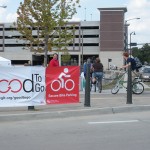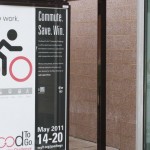Good to Go
The Problem
The increase of urban sprawl and pod-based zoning development has forced many American cities to be focused around the single-occupancy car trip. Coupling this with reduced funding for public transportation and sustainable infrastructure (and in turn reduced usage) leads to cities with diminished air quality, endless road construction, and declining individual health. Bloomington-Normal, Illinois was headed down this path.
The Project
Good To Go™ is a sustainable transportation initiative sponsored by the local NPR affiliate station WGLT and Illinois State University’s Office of Sustainability. Good To Go is a year-round media campaign promoting sustainable transportation in Bloomington-Normal, Illinois. The goal of the program and its annual Commuter Challenge event is to increase healthy lifestyles, help participants save money, and lower environmental impact by increasing the use of sustainable transportation such as biking, carpooling, walking, and riding the bus or train. An identity system and a grassroots marketing campaign was needed to give the movement an impactful and urgent visual presence.
Responsibilities
- Oversaw creative development of identity, print collateral, and web interface.
- Created and deployed grassroots marketing campaign.
- Organized communication between offices and creative team.
- Researched sustainable practices to lower environmental impact of marketing efforts.

The Solution
In order for the campaign to be successful, it had to practice what it preached. When creating the identity we strived for a familiar mark that could be reproduced easily on a variety of sustainable media, included recycled material, sidewalks, and digital applications. The infinity mark not only suggests environmental efficiency, but also the impact of complete trips taken without the car. The mark was simple, efficient, scalable, and immediately recognizable. A red and black color palette allowed the entire campaign to stand out against other “green” initiatives.
The Results
Good to Go quickly established itself as a trusted source of sustainable transportation news and programming. The branding was fast, ubiquitous, and immediate. Tabling events at Farmer’s Market, valet bike parking, and bus and electric car sponsorship visually distributed the brand to core audiences. The annual Commuter Challenge grew in participation in each year, effectively reducing carbon emissions, saving participants money (which would in turn be injected into the local economy), and increasing caloric burn day after day. The branding was so successful that it was adopted by the regional metropolitan planning organization in 2016, and continues today.









